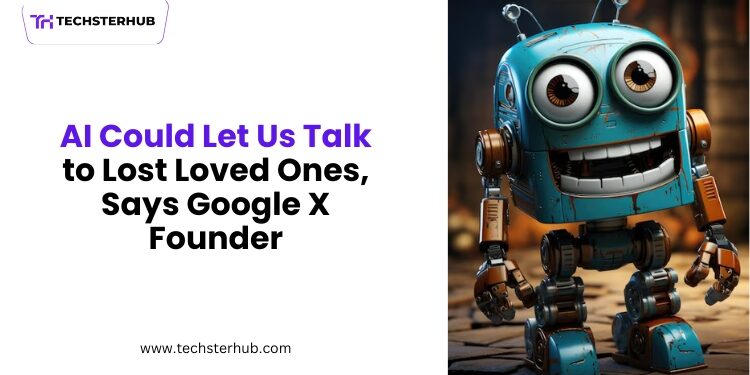Artificial Intelligence (AI) has long been associated with futuristic concepts, but now, it is inching closer to something that might seem like science fiction: AI technology will enable people to have conversations with their deceased relatives. The founder of Google X and AI expert Sebastian Thrun gained media attention when he talked about AI’s potential to generate “digital twins” for deceased individuals. Thrun explains that this technology might enable people to achieve a form of immortality because digital replicas could continue existing after their physical demise.
What Are Digital Twins?
The concept of “digital twin” means a computer-based representation of an actual physical object or person. Vast data sets enable the creation of virtual replicas that replicate the behaviors, personality traits and mannerisms of the original entity. To build a human digital twin requires data from social media posts along with videos and voice recordings as well as personal interactions. AI can simulate conversations and actions using information gathered from a person’s past after creating a digital twin.
If someone passes away their digital twin can be created using their digital footprints which include emails texts photos and voice recordings. Through digital twin technology people could ask questions and have conversations which would create the illusion that their beloved person remains alive digitally.
How AI Could Let People Converse with Departed Loved Ones
According to Sebastian Thrun’s vision we could soon use AI technology to communicate with deceased loved ones as though they had never left us. AI-powered systems enable the creation of digital counterparts who can respond to inquiries and take part in dialogues while providing guidance. With training from historical data AI systems could learn to replicate a person’s speech patterns, preferences and values to deliver responses that feel intimately personal.
It would be possible to seek guidance from a deceased relative on major life choices or to engage in casual daily conversations with them. Artificial intelligence systems have the potential to substitute for forgotten memories and generate interactions that feel authentic. Grieving individuals could find solace through an innovative approach that lets them maintain their bonds with lost loved ones.
Thrun sees that this technology has the potential to transform how people cope with losing a loved one. The physical absence of a person cannot be reversed but their emotional bond can persist through interactions with their digital representation. AI technology has the potential to redefine our perceptions of life and death along with transforming our grief processing methods.
The Technology Behind Creating Digital Twins
Developing digital twins requires significant effort and expertise. Creating digital twins requires collecting extensive data about the person who will be replicated. Machine learning and deep learning algorithms within AI enable data processing that reveals potential reactions of a person to various scenarios. An AI system has the capability to examine a person’s written communication and voice tone to project their responses to specific subjects.
A digital twin system must comprehend both the knowledge and preferences of a person and their emotional intelligence to represent how they felt about specific situations and people. The sophisticated NLP models that power chatbots such as ChatGPT hold significant potential for generating realistic and authentic conversations.
The creation of a digital twin allows a person’s “immortal” presence to maintain interactions with family and friends posthumously. They would have left behind a part of their essence that people could access at any time through AI-based platforms.
The Concept of Digital Immortality
The most compelling element of Thrun’s concept revolves around the idea of digital immortality. AI holds the potential to let someone’s consciousness survive beyond physical death through virtual representation. The technology-driven concept proposes a new understanding of life and death by demonstrating how technological advances can merge these states.
The concept of digital immortality does not imply that a person’s consciousness or soul survives death in a tangible way. Digital immortality involves preserving and simulating a person’s personality traits and memories so their essence can continue to engage with others. Digital immortality can serve as a source of solace for those in mourning by enabling them to maintain a sense of their loved ones’ presence after death.
Digital immortality challenges our understanding of what it means to be truly “alive.” Can a digital twin authentically embody the original person? Would this digital existence serve as an extension of their real life or just a hollow copy of it? The ethical and philosophical questions surrounding digital immortality are essential issues we need to explore as we advance toward this potential reality.
Potential Benefits of AI Digital Twins
- Emotional Comfort: Digital twins deliver immediate emotional support to people who are mourning. Digital interaction with digital representations of deceased loved ones may enable people to deal with their loss and reach emotional closure.
- Preserving Knowledge and Legacy: Digital twins have the ability to capture and maintain the knowledge and legacies of individuals who have greatly contributed to society or who possess valuable wisdom. What if people could continue to learn from a famous scientist’s ideas and guidance after their death?
- Personalized Interaction: Digital twins have the capability to adapt their interactions to fulfill the distinctive needs of each person. These digital replicas could offer personalized assistance and companionship based on the distinct personality traits and life experiences of the individuals they represent.
- Historical and Cultural Preservation: History and cultural preservation could benefit from the application of digital twins. The creation of digital replicas enables us to preserve records of influential figures’ thoughts and actions as well as their world contributions.
Ethical Concerns and Challenges
The concept of digital twins presents multiple ethical concerns despite its potential advantages.
- Privacy: The creation of digital twins demands extensive access to personal information. Ownership of digital data becomes problematic when considering its potential applications. The ethicality of utilizing personal data remains questionable after an individual’s death. The question of who should hold control over the digital twin remains unanswered.
- Authenticity: Digital twins represent separate entities from the actual individuals they model. AI can attempt to replicate an individual’s essence but will it remain an artificial simulation? The ability to “speak” with someone’s digital twin poses questions about authenticity and the appropriateness of interacting with a digital representation of someone who has passed away.
- Emotional Impact: Digital twins may provide solace to certain individuals but they have the potential to make the grieving process more difficult. The use of virtual versions of loved ones might lead people to become overly reliant on them to such an extent that it obstructs their ability to move forward after a loss.
Conclusion
Sebastian Thrun’s idea about digital twins combined with AI-driven conversations with the dead provides an intriguing look towards technological advancements. Science fiction could soon become reality as advancements in AI and machine learning make this concept more plausible with each passing day. The concept of digital immortality disrupts traditional views on life and death while presenting new methods for managing grief.
The advancement of technology demands careful consideration of the ethical consequences associated with digital reproductions of individuals and their family members. The practice of communicating with deceased loved ones offers comfort to many people while simultaneously challenging our definitions of “alive” existence and our understanding of life-death boundaries. We must carefully assess both advantages and obstacles when entering this new territory to ensure artificial intelligence continues to benefit our lives.











